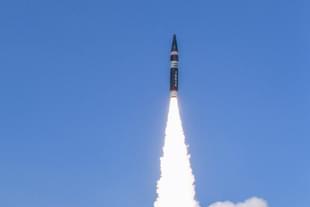News Brief
India Tests Agni Prime Nuclear-Capable Ballistic Missile
Swarajya Staff
Oct 21, 2022, 02:39 PM | Updated 03:14 PM IST
Save & read from anywhere!
Bookmark stories for easy access on any device or the Swarajya app.


The Defence Research and Development Organisation test-fired the Agni Prime nuclear-capable ballistic missile earlier today.
The missile, which has a range of between 1,000-2,000 kilometres, has been developed to strike targets in Pakistan. The stated range of the missile will not allow it to reach all major cities in China, most of which are located in the country's eastern coastal belt.
Reports suggest that the two-stage solid propellant ballistic missile will replace Prithvi, Agni 1 and Agni 2 missiles developed two decades ago. It is believed to be more accurate and easy to use than these missiles, which have technology that is considered largely outdated.
Many experts believe that the high accuracy and manoeuvrability of the missile could be used to target aircraft carriers.
"From whatever I have read, I think it's a maneuvering warhead and it can maneuver after reentry. So it can hit targets which are moving, for example ships. You might have heard of Chinese capability to hit aircraft carriers at long distances. [inaudible] systems give you that kind of capability," Dr Avinash Chander, former director-general of DRDO, told StratNews Global Editor-in-Chief Nitin Gokhale in a recent interview.
The missile's first known test was conducted in June 2021. It was tested for the second time in December of that year.
Agni Prime weigh 50 per cent less than Agni-III and is the lightest and smallest of the Agni series of missiles, reports says.
The missile is made up of composite material, which offers various advantages over conventional materials. Composites are lightweight, have better strength and offer greater design and production flexibility.
The new missile uses some technologies that the DRDO has developed for the long-range Agni-IV and Agni-V nuclear-capable ballistic missiles.
Agni Prime comes in a canisterised terised configuration, which significantly enhances the mobility of the missile and makes launch easier.
In canisterised configuration, the warhead can be permanently mated with the missile instead of having to be installed prior to launch. As a result, canisterisation significantly reduces the time required to launch a missile and improves the ability of the forces to respond to an attack quickly. Canisterisation also increases the reliability of a missile and its shelf-life.
For canisterisation, a missile mated with a nuclear warhead is sealed in a canister, which is placed atop a road-mobile launcher.
In the past, India has tested its Agni-5 intercontinental ballistic missile in canisterised configuration. The missile has a range of over 5,500 km.
A canisterised missile can be fired directly from the canister or cylindrical container containing the missile by elevating it.





